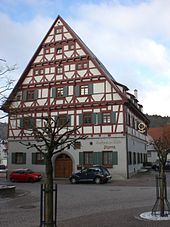Gasthaus zum Rößle (Schelklingen)
The Gasthaus zum Rößle is a bar and restaurant in Schelklingen in Baden-Württemberg , which is currently not in operation. Originally it served as the home of Hans Reuss von Reußenstein , later as an inn for the White Horse .
location
The building is centrally located in the middle of the city at the end of the wide Marktgasse street market. Several streets flow into the house: Stadtschreibereistraße from the north, Färbergasse from the south, Diehlesgäßle from the southwest, Langegasse from the west as an extension of Marktgasse coming from the east. The viewing gable faces Marktgasse and thus the town hall. This residential complex originally included a large barn and stables as well as other outbuildings in a large courtyard enclosed by a stone wall.
Building history
It is assumed that the building was built in the 16th century. Provided that it was built by Hans Reuss von Reußenstein himself, the construction period can be narrowed down to the last third of the 16th century. It is a very high, two-story gable building, the ground floor made of stone, the other floors made of half-timbered houses with a round arched, profiled portal made of stone. Above the portal in a figure niche was a Madonna, a wooden sculpture from the 18th century. On both sides of this niche there are two coat of arms fields with the coat of arms of the Renner von Allmendingen ( Allmendingen (Württemberg) ) (Siebmacher coat of arms no.116 in the list of Swabian noble families ), a soaring black horse. It is noticeable that the Reussenstein coat of arms, a soaring bear, is missing above the portal. Inside the house has a continuous central eye "with a mighty cellar neck and barrel-vaulted cellars".
In 1819 the building complex included the Rößle with a brewery and beer cellar, a barn behind the house, a wash house and pigsty attached to the south of the house, and finally the brandy distillery; There is also a wooden shed built to the west of the house, which was demolished in 1871 and replaced by a three-story building with a malt drying plant and a brandy distillery. The barn, newly built in 1873, was converted into apartments after 1945, and the wash house with the brandy distillery was demolished.
The barn or barn in the courtyard and the common walling belonged to the property from the beginning. Within the city, the building occupies an excellent and central place at the intersection of Marktstrasse / Lange Strasse and Stadtschreibereistrasse / Färbergasse.
owner
The current Gasthaus zum Rößle is generally considered to be the residence of Hans Reuss von Reußenstein (* 1539 - April 6, 1603), who died as the last of his family in Schelklingen and was buried in the parish church. Two of his grave slabs have been preserved there. Hans Reuss was with Agatha, geb. Renner von Allmendingen (Württemberg) and had at least one daughter named Agatha. His wife appears in the Schelklingen baptismal register in 1602 and 1621 as godmother, his daughter in 1608.
Since the source situation of the house is poor, only a few details can be given. It is reported that around 1600 "the Junkers von Reußenstein (...) owned a house, located on the square, at the three locations including its catch on the streets", today's Rößle. In 1625 “the former Reussian house was owned by the Junker Rudolf Schenk von Stauffenberg zu Bach (Erbach) , who paid 15 kr from it to the Urspring Monastery .” Around the middle of the 17th century the house was converted into an inn and inn with a brewery.
When the inn was sold on September 11, 1672 by the owner (not the landlord) and councilor Georg Wagner to Marx Aberdtshauser from Weilheim in Upper Bavaria , the accessories were named. Wagner sold his "usual home to the white Rößel, also barn and anligender Hofraithe, Prewkeßel, 2 Prewhäffen, Waich Standen, Kidbrenten, beer kegs, all belonging to the Prew beings, so much available as well as little something advisable things and everything zugehorender justice: and meet same and Wass matter of floor wax Zinß vnd stehendt payable "to 825 fl.
In the second half of the 17th century, the “White Horse” belonged to the mayor Georg Wagner, who had his son-in-law Christoph Eysell run the business. Christoph Eysell married Wagner's daughter in 1654, was often referred to as "Bürger und Gastgeb", "Gastgeb und Pürrbrew" and died in 1671. His wife died before him in 1669, after which he married Maria Strobler in the same year. In this context it is probably related that Georg Wagner sold the inn to Marx Abertshauser in 1672. In 1695, shortly before his death, the latter sold the “Herberg zum weissen Rösslein” for 1,037 fl to Georg Pfuhler, who married Ursula, Abertshauser's daughter, on October 29, 1695. Pfuhler was the owner until at least 1732. Simon Baumann was named as Rößlewirt between 1763 and 1773. In 1784 his son-in-law Franz Christian Dercum was the Rößlewirt; 1790 Johannes Vopper, 1793 Karl Kneer, Ursula Vopper's second husband. In 1806 the Rößle was bought by Joseph Weinbuch. Xaver Bund was the owner in 1819, then Adam Knupfer until 1831, Carl Menz in 1832, Johannes Bumiller in 1847, Bernhardt Straub and his widow from 1869 to 1881, Alphons Mantz from 1881 until after 1893, Willi Mantz in 1926, then Anton Mantz.
The building is a listed building and has been entered in the list of Schelklingen architectural monuments.
literature
- City Schelklingen (Hrsg.): Schelklingen: History and life of a city. Published by the city of Schelklingen on the 750th anniversary of the city from 1234–1984. Ulm: Süddeutsche Verlagsgesellschaft, 1984.
- Franz Rothenbacher: House book of the city of Schelklingen: House tables. Arranged by Franz Rothenbacher. Mannheim: Rothenbacher; Schelklingen: City of Schelklingen, City Archives, 1995.
Coordinates: 48 ° 22 ′ 33.8 " N , 9 ° 43 ′ 53.8" E





